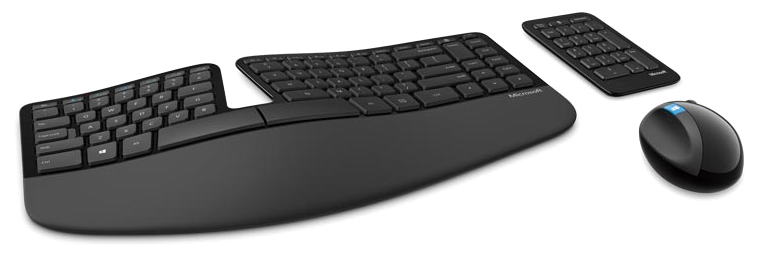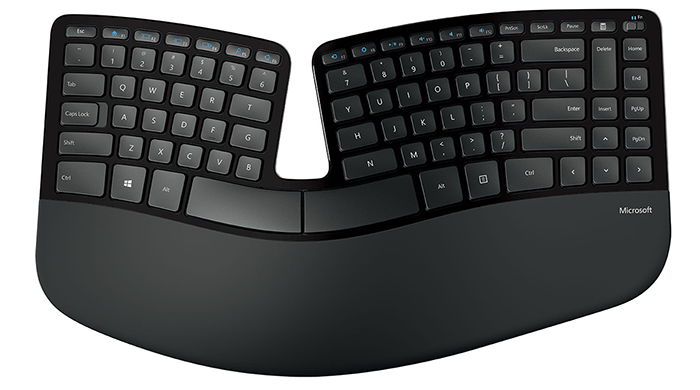Are The Old Ones Still The Best?
For those of you who spend the majority of your working day glued to a PC, have you given enough consideration to workplace ergonomics? I'm guilty of ignoring the pitfalls of sitting at a desk for long periods of time, and with intermittent back pain and early signs of RSI, I've decided to make some changes.
A new chair is high on the list of priorities, but first, it's time to try a new keyboard and mouse. My current Logitech set has served me well for many years, but I'm curious to see if an ergonomic replacement could help alleviate any discomfort without disturbing my flow. There are a fair few options on the market and I've opted to start my search with one of the most well-known solutions: Microsoft's Sculpt Ergonomic Desktop.
Launched a few years back and now available for under £70, the Microsoft package claims to offer "a relaxed, comfortable computing experience," but the first thing you'll notice is that it looks downright weird. There's an odd gap in the middle of the keyboard, the numpad is detached, the mouse is a strange shape, while the glossy plastics surrounding the keys have an uncanny ability to collect dust.
Unfamiliar Design
This isn't your traditional set of peripherals, yet in person I quite like the way it looks. The keyboard isn't as bulky as I'd feared - it measures 392mm at its longest point and could easily be slipped into a drawer when not in use - and this is one of those older gadgets that has the ability to come across as contemporary. It's a surprisingly good-looking piece of kit and feels well-built throughout.
As you'd expect from modern peripherals, all three components are wireless and communicate with the host PC via a small USB receiver. Microsoft uses the 2.4GHz wireless frequency, as opposed to Bluetooth, but the loss of a single USB port is no real hardship and, if you do choose to travel with the equipment, the USB dongle can be stowed neatly inside the mouse. Unfortunately, the battery configuration isn't quite as user friendly. Neither component is rechargeable, and each uses different batteries - it's two AA for the mouse, two AAA for the keyboard and a CR2430 for the numpad. All are provided in the box, and Microsoft quotes typical battery life as 36 months, but you will need to replace them all at some point.
When you first use the keyboard, you start by noticing everything that isn't quite right. None of the keys are backlit, there are no status LEDs for Caps Lock or battery life, the Home, PgUp and PgDn are squeezed together in an unfamiliar layout on the right-hand side, and the top row of keys feel flat and lifeless due to the way in which the keyboard tapers off toward the edges. You may find the lack of response off-putting if you happen to use Escape on a regular basis, and in a similar vein, there's no Fn shortcut, with Microsoft choosing to alternate the function of the top row via a switch in the top-right corner.
Getting Acclimatised
And then there's the typing experience, which for anyone unaccustomed to an ergonomic layout will feel completely alien to begin with. I was aghast at the number of typos I was making, and everything I knew about typing seemed to go right out of the window. In particular, the B key seemed problematic - it's usually in the middle, accessible via either hand, but on the Sculpt Ergonomic Desktop it's exclusively on the left.
There's a steep learning curve involved, but it's arguably worth the effort. After a fortnight of regular use I'm starting to feel properly acclimatised. The keys are like a hybrid between a good laptop and a proper desktop, meaning chiclet-style buttons that have mid-length travel and feel quick, agile and quiet. The split spacebar also works well, and though the soft-touch, cushioned palm rest gathers dirt and isn't easy to clean, it's well-sized and feels sumptuous to the touch.
Once you get to grips with the layout it's a very pleasant place to work, and you begin to realise how the ergonomic design may benefit your wrists. The way in which the keyboard is split and tapered upward in the centre helps encourage your hands to remain in line with your forearm, and there's also a bundled raiser bar that magnetically attaches to the bottom of the device. Choose to use it and you get a "reverse tilt" that is said to encourage a neutral wrist position. The unorthodox angle also takes some getting used to, but before long it too starts to feel instinctive and comfortable.












